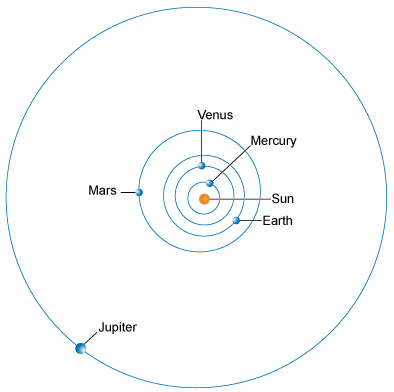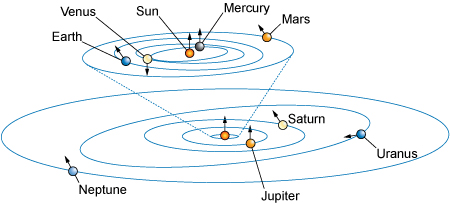1 Transits in the Solar System
What is a transit? As you learned in Week 1, a transit is what happens when a planet passes in front of the Sun and blocks some of the light from the Sun. Exoplanets – planets outside of the Solar System – can also transit their host star. For a transit to occur, the planet’s orbit must cross an imaginary straight line running from the observer to the star.
In our Solar System, the transits of only two of our fellow planets are visible from the Earth. Mercury and Venus transit the Sun because they are closer to the Sun than Earth is. Planets that orbit further from the Sun than the Earth does can never pass directly between the Earth and the Sun – we could only see their transits from a spaceship outside of the Solar System.
In Figure 1, you can see how only Mercury and Venus could possibly pass between the Sun and an observer on Earth.

Planets close to their star complete an orbit in less time than planets that are farther out. Last week you learned that 51 Peg b, which is very close to its star, completes an orbit in just a few Earth days. Mercury’s orbital period is 88 Earth days, while Venus’ orbital period is 225 Earth days. Earth’s orbital period is of course (just over) 365 Earth days – an Earth year.
Mercury overtakes Earth on the inside a few times in each Earth year, and Venus does the same thing roughly every one and a half Earth years. From this information, you might expect to see Mercury transit the Sun a few times each year, and Venus to transit the Sun approximately once every year and a half. But this isn’t what happens. The orbits of all the planets in the Solar System are slightly tilted, as shown in Figure 2a.

The tilted orbits mean that when the planets Mercury and Venus overtake Earth on the inside, they usually appear above or below the Sun. For a transit to occur, the planet has to line up exactly in two dimensions, so transits are quite rare. Figure 2b shows where Venus can line up exactly with the Sun. A transit happens only if Venus overtakes the Earth when it is at one of two particular places in its orbit.

In fact, there are only 13 transits of Mercury every century. Venus transits are even less frequent. The last transit of Venus was in 2012, and the next will be in December 2117.
